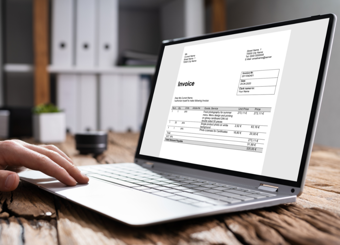Invoice data capture - a small but essential part of AP automation
What is Invoice Data Capture?
Invoice data capture is the process of managing a supplier invoice from the invoice receipt until the data has been interpreted (OCR’ed), extracted, and validated by a system or an operator.
The invoice data capture process usually consists of the following four steps:
- OCR and extraction
- Document classification
- Data validation and quality control
- Reporting and analysis
Step 1: OCR and Extraction
Best practices call for front-end imaging and data capture. There are an abundance of invoice data capture solutions on the market today. Companies looking to digitize their accounts payable process should make sure to select a solution that can handle any current (and future) supplier invoice format including email, PDF, e-invoices/EDI (such as XML), and paper.
Invoices sent as paper documents are scanned upon receipt, either at a central processing site or a remote facility, to digitize the data. Information is then captured using one of several types of recognition technologies. OCR (Optical Character Recognition) is the most commonly known character-based recognition system; ICR (Intelligent Character Recognition) is another widely-used technology.
OCR is defined as the mechanical or electronic conversion of images of typed, handwritten, or printed text into machine-encoded text. The result of an OCR process is a long string of words found on the document.
Data extraction is the act or process of retrieving data out of (usually unstructured or poorly structured) data sources for further data processing or storage. In the invoice data capture process this means applying business logic and validation rules to the OCR’ed data to minimize the need for manual verification.
Step 2: Document Classification and Validation
But invoice data capture solutions of today can do so much more than just presenting invoice data in a digitized, structured way. Most modern solutions provide the ability to capture specific fields, classify documents using key values and features, view invoice information, and correct errors or low-confidence characters.
While first-generation solutions used templates, second-generation products use self-learning technology or automated training methods to set up and facilitate classification. Next up is machine learning and AI, which is actually already live in some of the more advanced solutions. The difference here is that the solution seeks to understand the content of the data to figure out the relevant context, instead of using pre-configured templates or reading pre-defined titles and keywords. This means that every time you process an invoice the solution gets smarter, continuously improving your classification and validation of AP invoice data.
Step 3: Validation and Ensuring Accuracy
Invoice data capture solutions check the data extracted against user-defined business rules, as well as field specification, expressions, checksums, and line item validations. In this step, invoices get sorted and routed for validation. Some solutions can sort and route invoices to specific data validation assistants based on invoice type; others support automatic routing for four-eyes-principles, meaning two validation assistants validate the same invoice to quality assure the fields captured.
For highest automation levels, organizations can select to bypass manual validation and go straight through to workflow once a minimum data capture confidence level has been met. Invoices where data capture accuracy falls outside the predefined confidence levels will be moved to a separate work queue, where they can be manually verified and corrected by an AP department member.
Step 4: Analysis and Reporting
Some level of analytics and reporting is usually included in modern invoice data capture solutions. Standard reports include data on batch status, operator statistics, the accuracy of information extracted, and so on. While these are important metrics, you should also consider more detailed reports allowing for business critical insights across the organization. In fact, if your invoice data capture solution can provide aggregated reporting for invoice data on line level detail, the AP team can support the business with data-driven knowledge spend transparency and procurement policy compliance, as well as cash flow and working capital.
Selecting a holistic solution, covering both invoice data capture and workflow automation within the same interface, is beneficial for a unified view of the invoice process. With one solution companies can benefit from end-to-end reporting and higher automation levels across the entire AP process.
Six Tips When Selecting an Invoice Data Capture Solution
When accounts payable can support full spend transparency, it can then support critical business operations such as optimizing working capital, supporting strategic sourcing and improving cash liquidity - which is why choosing the right invoice data capture solution is critical.
Make sure your solution...
- Can handle any invoice format including paper, PDF invoices and e-invoices/EDI invoices to get one input channel with full insights - ensuring full control of your process.
- Captures line item details for increased workflow automation and full spend visibility.
- Is integrated with your invoice workflow solution to secure full end-to-end reporting and statistics and best in class automation rates by minimizing manual input.
- Requires limited change management and user training to enable fast adoption and implementation.
- Secures audit trails that provide end-to-end transparency of your AP process and ensure compliance to legislation and policies.
- Leverages the latest technology, such as AI and machine learning, to ensure your process is as automated as possible using the best technology available - therefore releasing your staff to focus on more important business operations tasks.






